|
The smartly attired 'victim' of the Cutter's incisive questioning who you see taking his seat at the 'Proms' is no other than that nonagenarian (it means he is well into his nineties) whose very name adorns the famous Portraiture Award Trophy; it is no other than that most respected of influential marquetarians, the legendary Horrie Pedder.
Although he is mostly house bound these days, our Horrie is still nonetheless, even now producing new marquetry pictures, which we have to say, are without a doubt well up to his customary very high standards. And those are of the very highest when it comes to marquetry!
Cutter. |
Introduction
A true Gentleman of Marquetry is Horrie, he has many decades of marquetry experience to share with us, so let us not waste any more time here with simple idle chatter, let's instead hear wonderful stories taken from those years of marquetry wisdom that is the marquetry career of Horrie Pedder.
So now it's over to you Cutter and your fascinating interview with master of marquetry art Horrie Pedder:
Cutter: We are here today to talk to Horrie Pedder of the Redbridge Marquetry Group.
Cutter: Hello Horrie, very nice to meet you, now you have been involved with marquetry a long time so how did you first get into the craft?
Horrie: It was reading a woodworker book which had a drawing of an ancient building at the back of the book. It also had a list of recommended suppliers. There was one fairly close to me in Palmers Green, it turned out to be someone's garage. You went over there to get your veneers - I bought several pieces myself. In one early magazine I saw an American artist doing a marquetry picture, so I started to buy the magazine regularly - this was back in the 50's and 60's, that magazine had a good influence on me. When I started out I did a few "stick as you go" pictures - you worked from the top to the bottom with those.
Cutter: What was the particular attraction of this craft?
Horrie: It was all the woods in various shades and colours that are required to create a picture - I found it fascinating - I'd never seen such pictures before.
It is also how the grains and flecks can be put to use in the pictures, you didn't think there was that much variation in the timber.
|
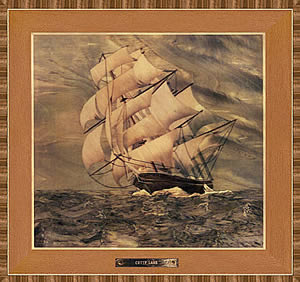 Cutty Sark
Cutty Sark
|
|
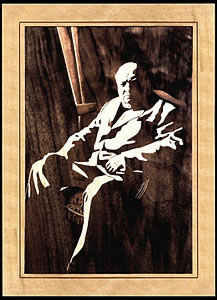 Sir Winston Churchill
Sir Winston Churchill
|
|
Cutter: Were you inspired by anyone’s work you had seen?
Horrie: Not until later, I'd done some marquetry myself to begin with. I used to attend the Handycraft Exhibition at Earls Court every year, you used to see some excellent work up there - leather work, woodwork etc, I did see a couple of marquetry pictures there. There was one of a leopard on a branch in a jungle I thought was very good. When I was up there one year I chanced across Charlie Good who was just clearing up his stall. I got talking to Charlie and he gave me a magazine about the Society, which I found very interesting, this magazine turned out to be The Marquetarian!
Cutter: Has the craft changed in style, presentation or difficulty, for example, since you first started?
Horrie: The finishing and the subjects chosen have really improved. In the early days we just did rather simple pictures, perhaps a clown or some scenery, yes, there was a lot of scenery then. It's all much more artistic today.
|
Cutter: I can’t quite establish when the window method came into general use as opposed to the stick as you go method, which one did you start with?
Horrie: I started with the stick as you go method - it was all we really had then.
Cutter: We have so many adhesives to choose from nowadays, we are spoilt for choice, which glued were used when you began making your pictures?
Horrie: I think it was possibly Evo-Stick - although I can't be sure. Quite often it was the glue that was normally supplied with the marquetry kits of the day. Cutter: The theme of the last question also applies to polishes, did you have a preference?
Horrie: French Polish - but you had to learn how to do it before you could do it properly. There was also, I think, a product called Furniglass that we used - it was a two stage process if I recall |
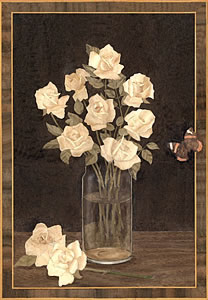 Butterfly and Roses
Butterfly and Roses
|
|
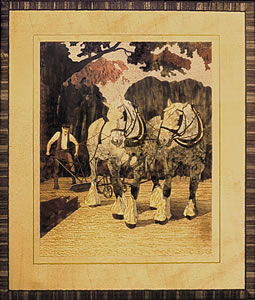 Ploughman and Cart Horses
Ploughman and Cart Horses
|
|
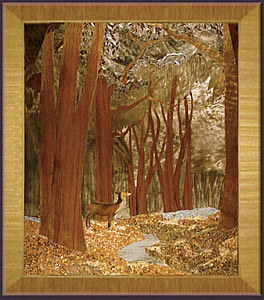 Forest Glade
Forest Glade
|
|
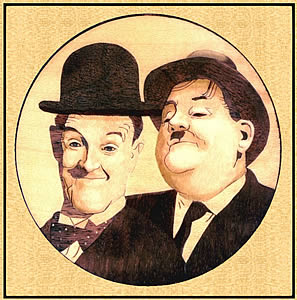 The Comedians
The Comedians
|
|
Cutter: Early pictures from the 1950’s and 60’s seemed to use the grain of the veneer to great effect; do you think there is less of this nowadays, and if you do, do you think it’s a loss to the craft?
Horrie: That was the original objective to use the grain of the wood. For instance, if you wanted to show a ploughed field, you would use a dark grained wood. The pictures today are more complicated, they are using the colour variations of each leaf of veneer now. The sky is the only thing left to the natural veneer itself - but even something like that in a piece of veneer is a job to get these days.
Cutter: Did you have any particular preferences for designs, and from where did you derive them?
Horrie: it's all rather a matter of taste, it should be something to please everybody - perhaps, a drop of water and a few trees, a sort of Constable scene. You could even go more complicated,
|
perhaps a nice indoor scene, it's whatever pleases your eye. You want it to be something you would like to hang up in your room. The final take on it is that it should be something that pleases you.
|
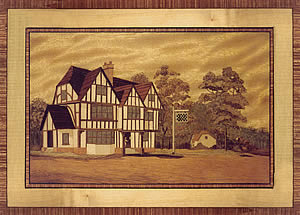 The Chequers
The Chequers
|
|
Cutter: How did you plan the initial stages of a new piece of work, for example, if working from a coloured picture, did you also take a monochrome copy to look at the tonal range?
Horrie: No - if you see a picture that pleases you, you have your own idea on how it should be represented - you work on it with a reference to your own veneer stock, otherwise it will not be successful.
You are more or less governed by your own veneer stock. You may have to wait until you can get the correct veneer otherwise you'll end up spoiling your picture. |
Cutter: Why did you choose to do any particular piece of marquetry, was it for yourself, a present, because it is a fascinating design or is it for the challenge?
Horrie: The important point is, if it appeals. I would always like to do a marquetry piece if it appealed to me, or indeed, other people. You know, it all boils down to being what you would like to hang on your wall in the end.
Cutter: Do you derive more pleasure from making a picture or an applied piece?
Horrie: I enjoyed making a rocking horse for my children, but, otherwise I'm restricted by space in the family home and unfortunately, a lack of an independent workshop.
So, it ends up that you're stuck to doing just pictures purely through a lack of space and room, mind you, I really do still like doing marquetry pictures anyway! I think that for doing something like an applied piece of furniture, you do need to be a carpenter in any case!
Cutter: Has marquetry been a definite relaxation for you?
Horrie: Definitely!
Cutter: Which item from all your work has given you the most satisfaction?
Horrie: A difficult question, there isn't a single particular one, I'd have to say that I would include all my flower themed pictures - my "Glasses" picture - the Cutty Sark picture - the Dhurer's Hands picture - the Flapper Girl. But, even so, somehow I've always thought that I could still improve on every one of those pictures, even, should I say it, every picture I've ever done! It perhaps could amount to being such things as: could I have used a better choice of veneers if I'd had them? Mind you, in saying that, I somehow think that my Stained Glass Window came out rather well in the end, yes I'm quite pleased with that one.
|
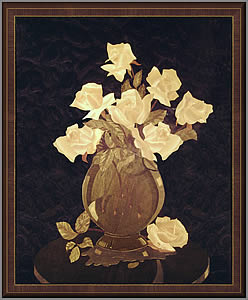
Vase of Roses on a Glass Table
|
|
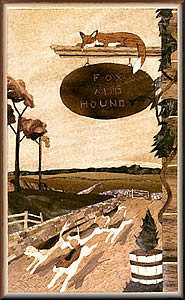 The Fox and Hounds
The Fox and Hounds
|
|
|
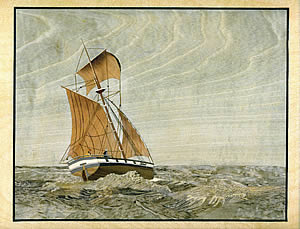
HMS Brilliant
|
|
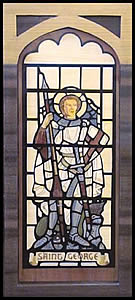 Stained Glass Window
Stained Glass Window
|
|
Cutter: Has there been any work made by any other member of the society which has left you thinking “I wish I had done that one”?
Horrie: There was a picture by Charlie Good that I really liked. It showed a monk standing by a leaded or stained glass window in an Abbey. That, I thought was a very nice picture.
Cutter: Have you kept all of your creations?
Horrie: The family has them now - and there are a few odd ones I've given to others.
Cutter: I’m sure that you have seen this question come up many times before, but what is your stance about the long standing debate of marquetry being an art or a craft?
Horrie: It all depends on the result, if you copy something it could be viewed as artistic - it really
|
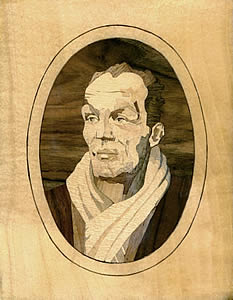 Our 'enery (Henry Cooper)
Our 'enery (Henry Cooper)
|
|
depends on your interpretation of the picture and your veneer construction of your chosen subject. The subject obviously plays an important part in deciding if it's art or not. The person doing the marquetry also plays their part in the equation.
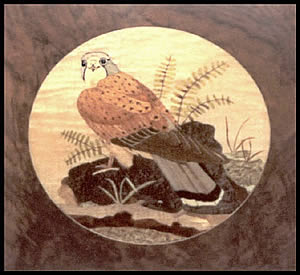 Kestrel
Kestrel |
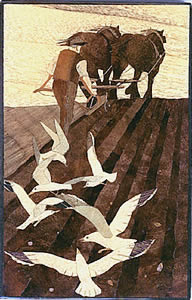 Following the Plough
Following the Plough
|
|
Cutter: The for or against coloured wood argument has gone on for years, what are your views on it?
Horrie: Scrub it!! Stick to harewoods and black wood. It's possible to use Ebony if you need something dark, but you may just as well paint a picture if you really want colours.
Cutter: Competition has been used to improve the standard of work since the society began, do you think it has used that over the years to see the standard improve?
Horrie: Oh yes, I would say so. The materials are much better today. You have a better finish, better veneers and - a better choice of subjects.
Cutter: If you think it has do you put that down to improved materials, better teaching or the competitive factor?
Horrie: The competitive aspect must improve things, but you have to take into account the better quality of today's glues - and better presses. The better presses came along with the better glues. You just have to remember the old stick as you go methods to see the improvements there are today.
Cutter: What is the first thing you would look for if judging at any level, is it the artistic impact or technical workmanship?
Horrie: The picture itself, what I mean is the artistic presentation. The subject itself is of prime importance. The workmanship would come next. I would make allowances for such things as the mitres, but not too much allowance if the cutting and the joints are rather poor. If there is a good picture, then technical bits such as finishing shouldn't be counted, they shouldn't, in effect, degrade it. Finishing can always be improved and bettered later on, it's the one thing you can go back over if you need to.
|
Hurrying your picture for a competition shouldn't be allowed to degrade it, especially if it's got potential. Have a think about it, a well selected and constructed picture once it's laid can't be changed without spoiling the picture, but the finish could always be sanded back down to the veneer level and then re-varnished, do you see what I mean?
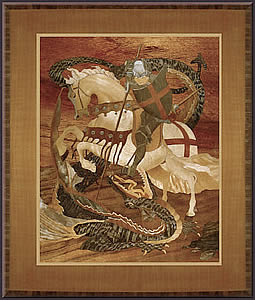
George and the Dragon
|
|
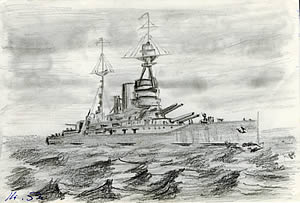
Charcoal sketch of a Battleship
|
|
Cutter: Do you enjoy judging?
Horrie: I would if I was younger - and with my years of marquetry experience I would indeed find it a pleasure, especially viewing the subjects and studying what the entrants have chosen for their pictures and applied pieces.
Cutter: You have given your name to the portraiture trophy. Is this because you have a particular liking for this difficult form of marquetry?
Horrie: There are two reasons behind my answer to this question - the first reason is that there was only the one or two portraits entered into the National Exhibitions in the fifties and sixties and there were no awards for portrait work at that time. A couple of those portraits were very good and so I thought that donating a trophy was worth it. I'm rather glad that I did it because we have seen some really good portraits since then.
Cutter: Do you think that there is any case for introducing any other media into marquetry, for example pyography?
Horrie: Definitely not, it's a different thing altogether. You can only scorch certain woods. If you want those darkening effects, then use sand scorching instead.
Cutter: Do you have any other crafts, hobbies or interests that share your available time?
Horrie: I like drawing and painting, but age and eyesight rather restricts me a little now. I always used to get high marks for drawing when I was at school - I'm a little out of practice now.
Cutter: “Excellent, thank you very much Horrie Pedder”.

|
|

![]()

![]()